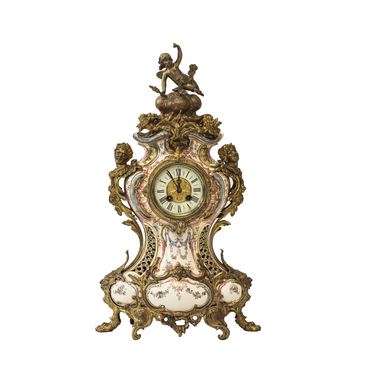The museum houses a clock, made by the French company “Gay& Lamaille”. “G.L.” mark on the back, located in a small oval in the lower-left corner, confirms its authenticity. The round face of the clock has Roman numerals. The hour and minute hands are made of blued steel. The height of the clock with the handle is about 30 centimeters, and the base is about 10 by 8 centimeters. According to experts, this clock was created around 1890.
The serial number “2889” is embossed under the stamp of the company. There is another branding on the back — “The Patent Surety Roller”. It denotes that the carriage clock has a special mechanism that ensures the accuracy of the movement.
During trips, the carriage would shake due to bumpy roads, and the clocks would stop running accurately. Inventor Moritz Immisch solved this problem. In 1879, he patented a spring-operated lever device, that put pressure on the star wheel (part of the clockwork) and prevented the inadvertent change of the movement. This device is sometimes called a jumper. The Paris clockmakers “Gay, Lamaille, and Company” acquired the patent for this invention in 1880. This firm also made clockwork mechanisms and sold them to other companies, such as Dent, Frodsham, and Parkinson & Frodsham.
The case of the clock presented in the museum has a classic design. Four glass side panels and the viewing window at the top of the case have beveled edges. The clock is equipped with a brass mechanism, which is designed to run for eight days when fully wound. It can be seen by opening the back door.
At the back of the mechanism is a spiral bell that signals the time. There are also two repeat buttons. This feature was built into the clock so that one could know the time at night without turning on the light. When the button is pushed, the clock strikes the last hour that has elapsed. When the other button is pushed, the clock “sounds” the number of five-minute intervals past in the last hour. In this way, it was possible to know quite precisely what time it was without looking at the face, but simply by counting the beats. The system worked due to the design of the gears located on the back panel.
The serial number “2889” is embossed under the stamp of the company. There is another branding on the back — “The Patent Surety Roller”. It denotes that the carriage clock has a special mechanism that ensures the accuracy of the movement.
During trips, the carriage would shake due to bumpy roads, and the clocks would stop running accurately. Inventor Moritz Immisch solved this problem. In 1879, he patented a spring-operated lever device, that put pressure on the star wheel (part of the clockwork) and prevented the inadvertent change of the movement. This device is sometimes called a jumper. The Paris clockmakers “Gay, Lamaille, and Company” acquired the patent for this invention in 1880. This firm also made clockwork mechanisms and sold them to other companies, such as Dent, Frodsham, and Parkinson & Frodsham.
The case of the clock presented in the museum has a classic design. Four glass side panels and the viewing window at the top of the case have beveled edges. The clock is equipped with a brass mechanism, which is designed to run for eight days when fully wound. It can be seen by opening the back door.
At the back of the mechanism is a spiral bell that signals the time. There are also two repeat buttons. This feature was built into the clock so that one could know the time at night without turning on the light. When the button is pushed, the clock strikes the last hour that has elapsed. When the other button is pushed, the clock “sounds” the number of five-minute intervals past in the last hour. In this way, it was possible to know quite precisely what time it was without looking at the face, but simply by counting the beats. The system worked due to the design of the gears located on the back panel.



